R.J. Stowell's Blog: rjsomeone, page 47
April 27, 2019
The 10 LPs every collector should own... Part 1
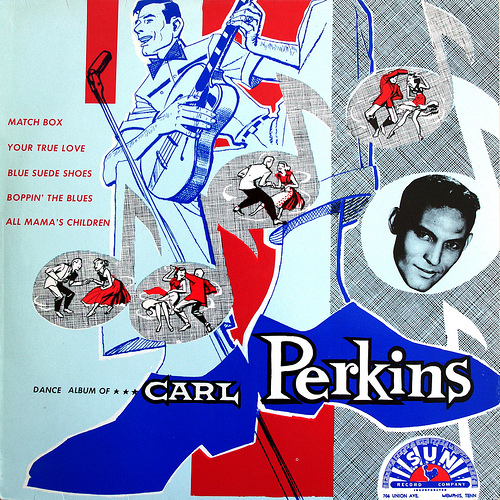 Doesn't matter who you are, the impact of your website or your radio show - if you create a definitive list of the 10 LPs that every record enthusiast must own, you'll do nothing but create havoc for yourself; indeed, you're probably wrong, and frankly you should have avoided the topic altogether. Instead, your focus should have been an article about the ten records that mean the most to you as a critic, or the ten most collectible... something that is measurable and inarguable.
Doesn't matter who you are, the impact of your website or your radio show - if you create a definitive list of the 10 LPs that every record enthusiast must own, you'll do nothing but create havoc for yourself; indeed, you're probably wrong, and frankly you should have avoided the topic altogether. Instead, your focus should have been an article about the ten records that mean the most to you as a critic, or the ten most collectible... something that is measurable and inarguable.If I were to choose for you, most of the readers at AM would know exactly what to expect. The choices wouldn't all be AM 10s, but they would nonetheless be relatively predictable. Instead, AM would like to offer up the 10 LPs that you, as an individual, with your tastes and opinions, should have in your collection. It's not magic or ESP. Here's Part 1:
No. 10: The White Album. It's not The Beatles best LP, though it may be to you; indeed it is more a compilation of solo tracks, not unlike Deja Vu. While a stellar LP nonetheless, The White Album is also the most important collectible LP. It's a rare group of individuals who knows of or truly understands the significance of the "butcher cover" (The Beatles, Yesterday and Today, Capitol, 1966) or can track down an "Unpeeled" Velvet Underground and Nico, but The White Album, officially The Beatles, is No. 10 on the list because everyone's copy is a thing of value. The unique numbering on both the U.K. and American releases has never been duplicated. And it doesn't matter if you had it as a kid and drew all over it, or it has a coffee cup ring - its value remains. Indeed, that copy you've had all these years is a personal thing; keep it, cherish it, draw on it some more, if you like. Then go out and splurge on a nice copy with the posters and the photos and a low number. It's a solid investment.
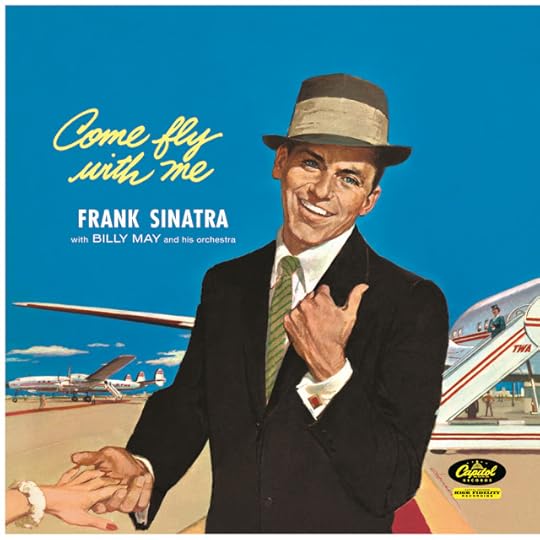
No. 9: (I suppose The White Album should be number 9, number 9, number 9; instead:) Many of our readers had their informative years in the 60s and 70s. With that in mind, No. 9 in our countdown is an LP by your favorite artist, which may very well be something you already own. If not, get yourself a mint condition copy of your favorite LP by your favorite artist. Both Crosby, Stills and Nash and Deja Vu, for instance, are classic LPs in iconic sleeves. The eponymous first LP has that iconic Henry Diltz photo of the trio sitting on a porch, and the latter has what may be the most handsome cover ever made, with its leather-like marbling and paste on photo - but these are just examples. For me, that LP is a mint condition mono Pet Sounds from The Beach Boys. Get yourself that first blue Weezer or NIN; doesn't matter - it needs only matter to you.
No. 8: In your collection, you should have a record that was a part of your childhood; an LP that your parents listened to or an older sibling - something that you can hear in your head when you were growing up. Having come from a family in the industry, this one's a hard choice for me. I'd either choose Jackie Gleason's Music for Lovers Only or Bobby Vinton's Greatest Hits. I can see in my mind both of them leaning against our console Magnavox stereo. Just looking at the cover should conjure up some kind of youthful imagery.
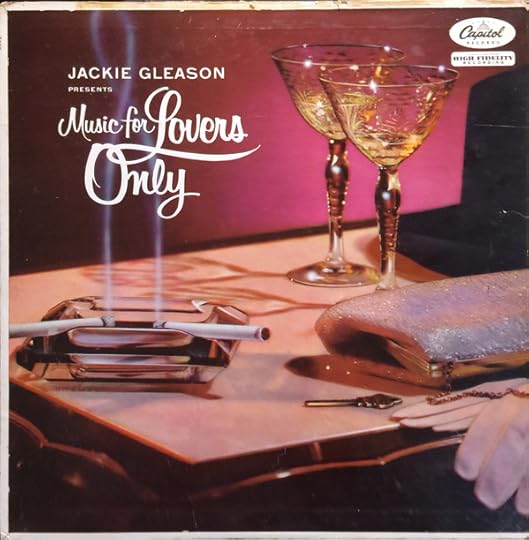
No. 7: A Frank Sinatra LP. I suggest either The Wee Small Hours of the Morning or Come Fly With Me. Choose either for its iconic cover painting which oozes 50s cool. Wee Small Hours is the more critically acclaimed LP here and is arguably the first concept album, while the songs are a bit melancholy. Come Fly With Me is far more accessible and full of hits. Either way, these are LP covers worthy of a frame, and tracks from the most iconic name in recorded music.
No. 6: Along the same lines, every collector should own a Sun Records LP. While AM's focus is often L.A. in the 60s, no collection can be without something by Elvis, Johnny Cash, Jerry Lee or Carl Perkins. Aside from the way-cool Sun label, there's a gritty garage feel to each LP. My faves are Greatest! by Johnny Cash or Carl Perkins' Dance Album of Carl Perkins. Like Sinatra, these are way cool with a bad boy bent.
Published on April 27, 2019 07:46
April 23, 2019
"Unsung" Heroes
 On the AM radio program, we highlighted the exceptional performance of two “unsung” vocalists, Clare Torry and Merry Clayton. "The Great Gig in the Sky," is the emotional outlet for an album that is otherwise perfectly contained and restrained. As the Guardian put it, Dark Side of the Moon is “like one long sigh” (I disagree, but I get it). Clare Torry's defining contribution was an afterthought as Alan Parsons, the LPs engineer and producer, brought in an unknown; someone who was not even a Floyd fan.
On the AM radio program, we highlighted the exceptional performance of two “unsung” vocalists, Clare Torry and Merry Clayton. "The Great Gig in the Sky," is the emotional outlet for an album that is otherwise perfectly contained and restrained. As the Guardian put it, Dark Side of the Moon is “like one long sigh” (I disagree, but I get it). Clare Torry's defining contribution was an afterthought as Alan Parsons, the LPs engineer and producer, brought in an unknown; someone who was not even a Floyd fan.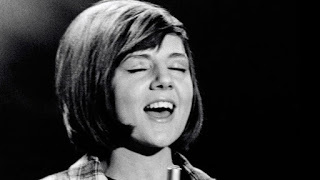
In the studio, Torry stepped up and asked the band, "Well, what do you want?" She says, "they had no idea." The instrumental mix found here (replete with Apollo 17 transmissions) could have been the final version. It's not terrible, but Torry brings it to life adding a new counterpoint melody that ultimately led to her receiving a co-writing credit. When Torry put on the headphones, she heard an even more stripped-down mix and was given no other direction than "We don't want any words." You know as well as I do that Clare knocked it out of the park, creating what this writer views as the single most superbly emotional vocal in the history of rock music.
Published on April 23, 2019 06:15
April 20, 2019
Merry Clayton - 50 Years Ago
The AM radio show, heard weekdays on iHeart Radio and at Daybreak USA (click on the sidebar), highlighted the seminal performances of two of rock's greatest singers; two women whose names you probably don't know: Clare Torry, whose gospel vocal on Pink Floyd's "The Great Gig in the Sky" is one of rock's shining moments; and Merry Clayton on the Rolling Stones' "Gimmer Shelter." While a myriad of rock's greatest singers have legions of familiar offerings, there are those whose repertoire consists of just one song, and that's all we need.
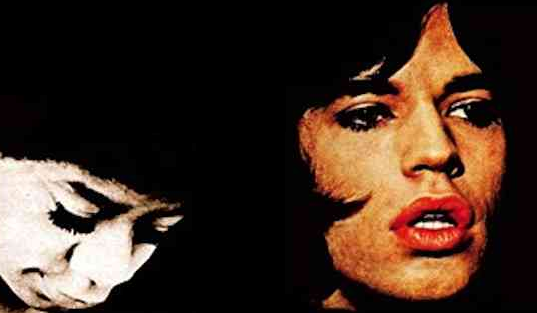
Imagine "Great Gig" with just Wright's tune and keys and Gilmour's slide guitar – still phenomenal, but, come on…
Same with "Gimme Shelter." Keith's "freaky, tremolo-drenched riff like something straight out of the future — or at least a very chilling alternate present,” as Guitar World put it, but remove Merry Clayton's howl and yowl and what have you got? A pretty good Stones tune, but again, come on.
Jagger remembers that "we randomly phoned up this poor lady in the middle of the night, and she arrived in her curlers and proceeded to do that in one or two takes, which is pretty amazing. She came in and knocked off this rather odd lyric. It’s not the sort of lyric you give anyone — 'Rape, murder/It’s just a shot away' — but she really got into it, as you can hear on the record." Pregnant and getting ready for bed before she got the call from producer Jack Nitzsche, Merry politely bowed out until her husband said: "Honey, you know, you really should go and do this date." The incredible performance, though, would indeed turn tragic. That night, Clayton miscarried.
Merry, though, turned what is assuredly a good song – but no more – into rock canon.
Published on April 20, 2019 08:31
April 11, 2019
Bed-In for Peace
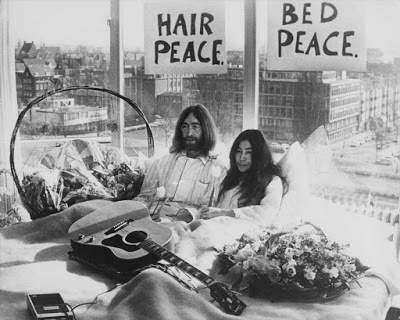 In March 1969, the press received word that John Lennon was holding court for… something or other at the Amsterdam Hilton. It was a Beatle, so it didn't matter what. John and Yoko Ono had married, in secret, five days prior in Gibraltar. They would use the associated press coverage upon their announcement to "Spread the message of love, like butter."
In March 1969, the press received word that John Lennon was holding court for… something or other at the Amsterdam Hilton. It was a Beatle, so it didn't matter what. John and Yoko Ono had married, in secret, five days prior in Gibraltar. They would use the associated press coverage upon their announcement to "Spread the message of love, like butter."The couple appeared naked on the cover of their 1968 LP Unfinished Music No.1: Two Virgins, an unmade bed behind them. So, when journalists heard they'd get access to Lennon and Ono in their honeymoon suite, they arrived hoping to witness a sideshow. What they found were John and Yoko in white pajamas and robes surrounded by bouquets and posters about Peace and Love.
 From March 25th through 31st in Amsterdam—and then from May 26th to June 2nd at the Queen Elizabeth Hotel in Montreal, Canada—Lennon and Ono received visitors between the 9 a.m. and 9 p.m. They held babies and gave advice sometimes straight from Beatles lyrics: "Come together" or "All you need is love!" The philosophical art project lasted more than two months. Keep in mind, this was coming off a Beatles year that included the release of the White Album, the film and soundtrack to Yellow Submarine and Abbey Road.
From March 25th through 31st in Amsterdam—and then from May 26th to June 2nd at the Queen Elizabeth Hotel in Montreal, Canada—Lennon and Ono received visitors between the 9 a.m. and 9 p.m. They held babies and gave advice sometimes straight from Beatles lyrics: "Come together" or "All you need is love!" The philosophical art project lasted more than two months. Keep in mind, this was coming off a Beatles year that included the release of the White Album, the film and soundtrack to Yellow Submarine and Abbey Road.Sometimes the message was so simple it came off as cryptic. Lennon said simply, "It's an achievement to eat your breakfast and it’s an achievement to brush your teeth." Simple philosophy really. A better world comes from a better home, but even that can be a challenge.
Rolling Stone said, "A five-hour talk between John Lennon and Richard Nixon would be more significant than any Geneva Summit Conference between the U.S.A. and Russia." Lennon himself said that Henry Ford knew how to sell cars by advertising. "I sell peace and Yoko and I are just a big advertising campaign." He'd go on to say, "Really, we're Mr. and Mrs. Peace."
Published on April 11, 2019 16:28
April 5, 2019
Jimi at Monterey
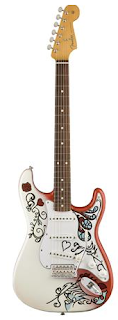 It was at Monterey that Seattle born Jimi Hendrix would make his American debut. Here was Jimi, 24 years old, nervous as all heck, hair wild, red pants, a velour vest, and a Fender Stratocaster - and after 40 minutes, with songs like "Hey Joe" and "Purple Haze" behind him, on his knees, Jimi summoned fire from his guitar. You've seen the photograph. It's one of the most famous rock portraits of all time. After three days that not only rocked but changed the world, Jimi heralded in The Summer of Love.
It was at Monterey that Seattle born Jimi Hendrix would make his American debut. Here was Jimi, 24 years old, nervous as all heck, hair wild, red pants, a velour vest, and a Fender Stratocaster - and after 40 minutes, with songs like "Hey Joe" and "Purple Haze" behind him, on his knees, Jimi summoned fire from his guitar. You've seen the photograph. It's one of the most famous rock portraits of all time. After three days that not only rocked but changed the world, Jimi heralded in The Summer of Love.For rock 'n' roll, it was the equivalent of the first performance of Bach's Brandenburgs or Gershwin's Rhapsody in Blue. Born in Seattle in 1942, Hendrix was unknown to America in 1967. He'd left home at 17 to join the Army, the Airborne Division no less, and there became a rhythm and blues sideman. Soon after discharge, Chas Chandler of the Animals took him to England with the promise of making him a star; that was 1966, just a year before Monterey. While Hendrix was a flop at home, he was an unabashed success in the U.K.; so much so that Paul McCartney suggested he appear at Monterey Pop.
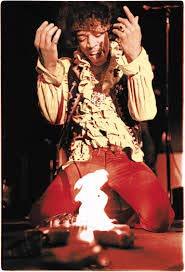 For 40 minutes the sky above Monterey snarled with Jimi's thunder. He played behind his back, with his teeth, a down and dirty sensual assault. But funny, it didn't start out that way. In the opener, a cover of Howling Wolf's "Killing Floor," Hendrix seemed almost timid, giddy or afraid. He said to the audience, "My fingers won’t move as you can see; you don't hear no sounds as you hear. But, dig this," his words emphasizing his nervousness. But then, a single note builds and builds until some kind of nuclear flareup leads into Foxy Lady. He'd played Dylan and The Leaves and would end the night with The Trogg's Wild Thing, but first he tore down everything that had come before, his guitar ripping through the audience, through the evening sky like a bombardier, all in harmonics and blues feedback and even a hint of Sinatra's "Strangers in the Night," played as if it was a battle hymn. And if that wasn't enough, Hendrix then sacrificed his guitar, the broken, burning Strat still calling out in the night.
For 40 minutes the sky above Monterey snarled with Jimi's thunder. He played behind his back, with his teeth, a down and dirty sensual assault. But funny, it didn't start out that way. In the opener, a cover of Howling Wolf's "Killing Floor," Hendrix seemed almost timid, giddy or afraid. He said to the audience, "My fingers won’t move as you can see; you don't hear no sounds as you hear. But, dig this," his words emphasizing his nervousness. But then, a single note builds and builds until some kind of nuclear flareup leads into Foxy Lady. He'd played Dylan and The Leaves and would end the night with The Trogg's Wild Thing, but first he tore down everything that had come before, his guitar ripping through the audience, through the evening sky like a bombardier, all in harmonics and blues feedback and even a hint of Sinatra's "Strangers in the Night," played as if it was a battle hymn. And if that wasn't enough, Hendrix then sacrificed his guitar, the broken, burning Strat still calling out in the night.Woodstock is more famous, and maybe it was The Stones who turned Rock 'n' Roll into Rock with "Satisfaction," but it was Jimi who ushered in Rock's golden age.
Published on April 05, 2019 16:29
April 4, 2019
Buy The Book
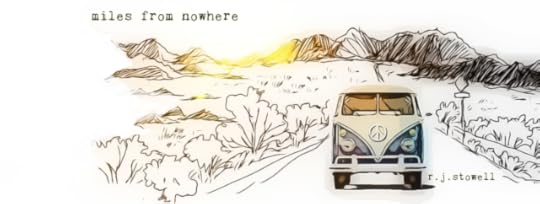
Last week there were 38,500 listeners to the AM broadcast, and many of you readers fit into that category as well. We at AM thank you for your loyalty, for listening, for reading and for writing us with your questions and suggestions.
But we have a request: Read the Book! AM, here on the web and on the radio, is sponsored by your patronage through the sale of R.J. Stowell's novel, Miles From Nowhere (and from Jay and the Americans). We've arranged for you to read Miles on Kindle Unlimited for FREE, while the Kindle edition for those of you without KU is just $2.99. The trade edition is $10.99.
And here's a new offer because you've asked. Now you can get a personally signed edition of either novel for just $19.99. I will sign the novel to you or a loved one with a personal note. Send an email to this link:
rjsomeone@gmail.com
Published on April 04, 2019 06:50
More Monterey and Janis
When we think of Lennon, it's with admiration; of Hendrix, reverence; with Morrison, it's conjecture and speculation. Like Cathy Heathcliff in Wuthering Heights, Morrison transcends death; the legend looms so much larger than his 27 years. For others we aren't so steadfastly obleeged.
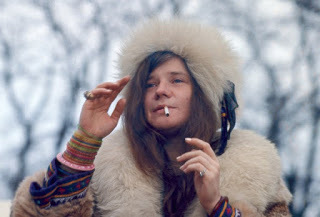 Janis Joplin shared Morrison’s California ideology with far less pomp and grandeur, yet she created a legacy equal to that of any 20th century blues vocalist. From Billy Holiday to Nina Simone, no one captured the gritty sentiment of the blues more effectively than Janis. Big Brother and the Holding Company’s Cheap Thrills (AM9) is a 60s' powerhouse raw-blues LP. The band, unfairly referred to at times as Janis Joplin and Some Other People, is the go-to album of blues-rock. From R. Crumb's seminal sleeve to Janis Joplin's vocals to the fuzzed out psychedelia of the band, this is the ultimate acid-experience. The "live" trappings, like those of Sgt. Pepper, are pretense (with the exception of "Ball and Chain," the only purely live experience), but the music has all the fire and spontaneity of a true live recording. For a band that supposedly had no musical talent beyond their lead singer, they sure did make a beautiful racket. "Summertime" is one of the all-time great rock interpretations of a standard; "I Need a Man to Love" has all the soul and power that Aretha Franklin was bringing to a much different idiom around the same time; "Piece of My Heart" has been tamed through commercial exposure, yet it remains an authentically passionate performance and a high-water mark for 60s radio. Cheap Thrills is the perfect document of its time and place, but also, like Memphis in the '50s or London in '77, an enduring testament to the unleashed power of song.
Janis Joplin shared Morrison’s California ideology with far less pomp and grandeur, yet she created a legacy equal to that of any 20th century blues vocalist. From Billy Holiday to Nina Simone, no one captured the gritty sentiment of the blues more effectively than Janis. Big Brother and the Holding Company’s Cheap Thrills (AM9) is a 60s' powerhouse raw-blues LP. The band, unfairly referred to at times as Janis Joplin and Some Other People, is the go-to album of blues-rock. From R. Crumb's seminal sleeve to Janis Joplin's vocals to the fuzzed out psychedelia of the band, this is the ultimate acid-experience. The "live" trappings, like those of Sgt. Pepper, are pretense (with the exception of "Ball and Chain," the only purely live experience), but the music has all the fire and spontaneity of a true live recording. For a band that supposedly had no musical talent beyond their lead singer, they sure did make a beautiful racket. "Summertime" is one of the all-time great rock interpretations of a standard; "I Need a Man to Love" has all the soul and power that Aretha Franklin was bringing to a much different idiom around the same time; "Piece of My Heart" has been tamed through commercial exposure, yet it remains an authentically passionate performance and a high-water mark for 60s radio. Cheap Thrills is the perfect document of its time and place, but also, like Memphis in the '50s or London in '77, an enduring testament to the unleashed power of song.
The band was formed by Peter Albin, Sam Andrew, James Gurley and Chuck Jones in a Victorian mansion/boarding house owned by Peter's uncle at 1090 Page Street in Haight-Ashbury. That house became the site of Wednesday night jam sessions that were organized by Chet Helms who was the real "Big Brother," naming the band, bringing James Gurley into the fold. The band had what Sam Andrew called a "progressive-regressive hurricane blues style."
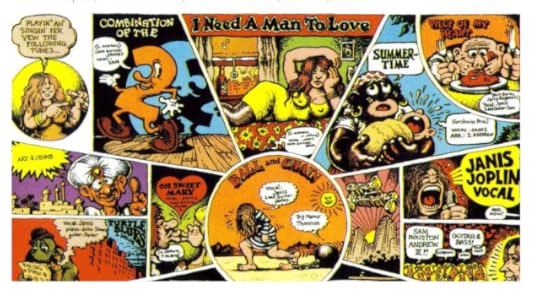 During the winter of '66, Chuck Jones left the band and was replaced by Dave Getz who played his first gig with the band on 12 March at the Matrix on Fillmore Street. Peter Albin was the main vocalist at this time, and although Sam Andrew helped out with the singing, both men knew that the band needed a singer who could match the group's instrumental energies. Chet Helms remembered a friend from his University of Texas days, Janis Joplin, and proposed that he bring her back to San Francisco, where she had tried to launch a singing career in 1963-1964. Janis came to town, sang a couple of tunes with the band at their Henry Street studio, and was enthusiastically welcomed into the group.
During the winter of '66, Chuck Jones left the band and was replaced by Dave Getz who played his first gig with the band on 12 March at the Matrix on Fillmore Street. Peter Albin was the main vocalist at this time, and although Sam Andrew helped out with the singing, both men knew that the band needed a singer who could match the group's instrumental energies. Chet Helms remembered a friend from his University of Texas days, Janis Joplin, and proposed that he bring her back to San Francisco, where she had tried to launch a singing career in 1963-1964. Janis came to town, sang a couple of tunes with the band at their Henry Street studio, and was enthusiastically welcomed into the group.
Big Brother acquired a new manager at Monterey Pop, Albert Grossman, who brought them to Columbia Records where they made their second album, Cheap Thrills, which was No. 1 on the charts for eight weeks. The music on the album was energetic and driving, the perfect match for Joplin's voice. Guitar Player magazine called James Gurley the "Father of the Psychedelic Guitar."
What sets this music apart from other bands of its time was the combination of terrific, brilliantly orchestrated and arranged instrumentals, Joplin's amazing, spectacularly expressive vocals channeling the agony ("I Need a Man To Love") and the ecstasy ("Summertime") of love and life in the bluesiest blues to come out of Texas (by way of San Francisco). The standout are of course, "Piece of My Heart" and the showstopping "Ball and Chain." A little more than a year following Woodstock, like Jimi a month before her, Janis would be gone.
Joplin was born in Port Arthur, Texas, an oil refinery town, in 1943. As a teenager in the late 1950s, she had read about Jack Kerouac and the Beatniks, began to dress in her own style, and started listening to blues music with her few high school friends. Blues singers like Bessie Smith and Leadbelly were among her favorites. Born in Port Arthur, Texas, Joplin had made her way to California and ended up in San Francisco's music and hippie scene. At Monterey Pop she captured national attention with her incredible performance of "Ball and Chain." From that point on, she became a national phenomenon.
 Janis Joplin shared Morrison’s California ideology with far less pomp and grandeur, yet she created a legacy equal to that of any 20th century blues vocalist. From Billy Holiday to Nina Simone, no one captured the gritty sentiment of the blues more effectively than Janis. Big Brother and the Holding Company’s Cheap Thrills (AM9) is a 60s' powerhouse raw-blues LP. The band, unfairly referred to at times as Janis Joplin and Some Other People, is the go-to album of blues-rock. From R. Crumb's seminal sleeve to Janis Joplin's vocals to the fuzzed out psychedelia of the band, this is the ultimate acid-experience. The "live" trappings, like those of Sgt. Pepper, are pretense (with the exception of "Ball and Chain," the only purely live experience), but the music has all the fire and spontaneity of a true live recording. For a band that supposedly had no musical talent beyond their lead singer, they sure did make a beautiful racket. "Summertime" is one of the all-time great rock interpretations of a standard; "I Need a Man to Love" has all the soul and power that Aretha Franklin was bringing to a much different idiom around the same time; "Piece of My Heart" has been tamed through commercial exposure, yet it remains an authentically passionate performance and a high-water mark for 60s radio. Cheap Thrills is the perfect document of its time and place, but also, like Memphis in the '50s or London in '77, an enduring testament to the unleashed power of song.
Janis Joplin shared Morrison’s California ideology with far less pomp and grandeur, yet she created a legacy equal to that of any 20th century blues vocalist. From Billy Holiday to Nina Simone, no one captured the gritty sentiment of the blues more effectively than Janis. Big Brother and the Holding Company’s Cheap Thrills (AM9) is a 60s' powerhouse raw-blues LP. The band, unfairly referred to at times as Janis Joplin and Some Other People, is the go-to album of blues-rock. From R. Crumb's seminal sleeve to Janis Joplin's vocals to the fuzzed out psychedelia of the band, this is the ultimate acid-experience. The "live" trappings, like those of Sgt. Pepper, are pretense (with the exception of "Ball and Chain," the only purely live experience), but the music has all the fire and spontaneity of a true live recording. For a band that supposedly had no musical talent beyond their lead singer, they sure did make a beautiful racket. "Summertime" is one of the all-time great rock interpretations of a standard; "I Need a Man to Love" has all the soul and power that Aretha Franklin was bringing to a much different idiom around the same time; "Piece of My Heart" has been tamed through commercial exposure, yet it remains an authentically passionate performance and a high-water mark for 60s radio. Cheap Thrills is the perfect document of its time and place, but also, like Memphis in the '50s or London in '77, an enduring testament to the unleashed power of song.The band was formed by Peter Albin, Sam Andrew, James Gurley and Chuck Jones in a Victorian mansion/boarding house owned by Peter's uncle at 1090 Page Street in Haight-Ashbury. That house became the site of Wednesday night jam sessions that were organized by Chet Helms who was the real "Big Brother," naming the band, bringing James Gurley into the fold. The band had what Sam Andrew called a "progressive-regressive hurricane blues style."
 During the winter of '66, Chuck Jones left the band and was replaced by Dave Getz who played his first gig with the band on 12 March at the Matrix on Fillmore Street. Peter Albin was the main vocalist at this time, and although Sam Andrew helped out with the singing, both men knew that the band needed a singer who could match the group's instrumental energies. Chet Helms remembered a friend from his University of Texas days, Janis Joplin, and proposed that he bring her back to San Francisco, where she had tried to launch a singing career in 1963-1964. Janis came to town, sang a couple of tunes with the band at their Henry Street studio, and was enthusiastically welcomed into the group.
During the winter of '66, Chuck Jones left the band and was replaced by Dave Getz who played his first gig with the band on 12 March at the Matrix on Fillmore Street. Peter Albin was the main vocalist at this time, and although Sam Andrew helped out with the singing, both men knew that the band needed a singer who could match the group's instrumental energies. Chet Helms remembered a friend from his University of Texas days, Janis Joplin, and proposed that he bring her back to San Francisco, where she had tried to launch a singing career in 1963-1964. Janis came to town, sang a couple of tunes with the band at their Henry Street studio, and was enthusiastically welcomed into the group. Big Brother acquired a new manager at Monterey Pop, Albert Grossman, who brought them to Columbia Records where they made their second album, Cheap Thrills, which was No. 1 on the charts for eight weeks. The music on the album was energetic and driving, the perfect match for Joplin's voice. Guitar Player magazine called James Gurley the "Father of the Psychedelic Guitar."
What sets this music apart from other bands of its time was the combination of terrific, brilliantly orchestrated and arranged instrumentals, Joplin's amazing, spectacularly expressive vocals channeling the agony ("I Need a Man To Love") and the ecstasy ("Summertime") of love and life in the bluesiest blues to come out of Texas (by way of San Francisco). The standout are of course, "Piece of My Heart" and the showstopping "Ball and Chain." A little more than a year following Woodstock, like Jimi a month before her, Janis would be gone.
Joplin was born in Port Arthur, Texas, an oil refinery town, in 1943. As a teenager in the late 1950s, she had read about Jack Kerouac and the Beatniks, began to dress in her own style, and started listening to blues music with her few high school friends. Blues singers like Bessie Smith and Leadbelly were among her favorites. Born in Port Arthur, Texas, Joplin had made her way to California and ended up in San Francisco's music and hippie scene. At Monterey Pop she captured national attention with her incredible performance of "Ball and Chain." From that point on, she became a national phenomenon.
Published on April 04, 2019 06:22
March 28, 2019
By the time we got to Woodstock
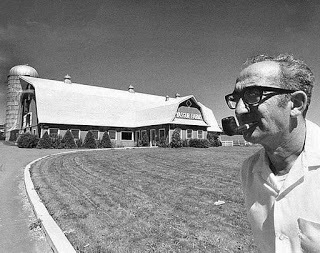 Max YasgurArtie Kornfeld and Michael Lang's original proposal was to build a recording studio and retreat for rock musicians in Woodstock, New York where Dylan, The Band and other musicians had already set up shop; kind of a rock ghetto, an eastern Laurel Canyon. The idea morphed into a two-day rock concert for 50,000 (25,000 per day) people with the hope that they'd raise enough money for the studio's construction. Along with partners John Roberts and Joel Rosenman, Woodstock Ventures got to work organizing the festival in an industrial park in nearby Wallkill, after both a Woodstock site and a nearby venue in Saugerties fell through. They printed tickets (initially $6.50 for one day, $13 for two days, and $18 for three days - roughly the equivalent of $120 today), which could be purchased in select stores or by mail through a post office box at Radio City Station. Although they were quite savvy organizing the festival itself, despite its pending roadblocks, they had little experience hiring the bands to play. It was part and parcel to the cavalier approach the young entrepreneurs would take.
Max YasgurArtie Kornfeld and Michael Lang's original proposal was to build a recording studio and retreat for rock musicians in Woodstock, New York where Dylan, The Band and other musicians had already set up shop; kind of a rock ghetto, an eastern Laurel Canyon. The idea morphed into a two-day rock concert for 50,000 (25,000 per day) people with the hope that they'd raise enough money for the studio's construction. Along with partners John Roberts and Joel Rosenman, Woodstock Ventures got to work organizing the festival in an industrial park in nearby Wallkill, after both a Woodstock site and a nearby venue in Saugerties fell through. They printed tickets (initially $6.50 for one day, $13 for two days, and $18 for three days - roughly the equivalent of $120 today), which could be purchased in select stores or by mail through a post office box at Radio City Station. Although they were quite savvy organizing the festival itself, despite its pending roadblocks, they had little experience hiring the bands to play. It was part and parcel to the cavalier approach the young entrepreneurs would take.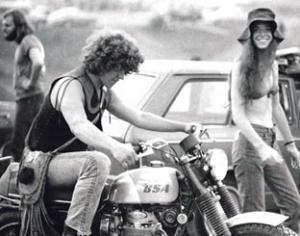 Michael LangAs Woodstock Ventures were finalizing their plans, things began to unravel. No matter how the young men and their lawyers spun it, the citizens of Wallkill did not want a "bunch of drugged-out hippies" descending on their town. After much wrangling, and political coaxing by Governor Nelson Rockefeller, the town of Wallkill passed a law on July 2, 1969 that banned the concert from the vicinity. Only a month-and-a half before the Woodstock Festival was to begin, a new location had to be secured. Again.
Michael LangAs Woodstock Ventures were finalizing their plans, things began to unravel. No matter how the young men and their lawyers spun it, the citizens of Wallkill did not want a "bunch of drugged-out hippies" descending on their town. After much wrangling, and political coaxing by Governor Nelson Rockefeller, the town of Wallkill passed a law on July 2, 1969 that banned the concert from the vicinity. Only a month-and-a half before the Woodstock Festival was to begin, a new location had to be secured. Again.Fortunately, in mid-July Max Yasgur offered up his 600-acre dairy farm in Bethel, some 50 miles from Woodstock, for $15,000; the cost, he said, to reseed and return the property to its pre-concert state. As lucky as they were to have found a new location, the last minute change of venue seriously set back the Festival timeline. New contracts to rent the dairy farm and surrounding areas had to be drawn up and permits acquired. Construction of the stage, a performers' pavilion, parking lots, concession stands, and a children's playground were nearly left undone.
Meanwhile, Michael Lang cleverly surmised that if he could secure at least one major artist, the rest would follow. The first act to sign, at a fee of $10,000, was Creedence Clearwater Revival. It wasn't quite what Lang was after, but the catalyst, nonetheless, to put the gears in motion. Soon after, Janis Joplin, The Who and The Jefferson Airplane signed on, and finally, Jimi Hendrix at an unprecedented $18,000. CCR drummer, Doug Clifford said, "Once Creedence signed, everyone else jumped in line." Despite the $10,000 fee, Creedence would be scheduled to play at 3am on Saturday, August 16th. John Fogherty subsequently declined the band's inclusion in the film.
As time advanced, more problems arose. It soon appeared that the 50,000 attendee estimate was far too conservative and a new approximation jumped to 200,000. The young entrepreneurs rushed to bring in more toilets, water and food, though based on a sketchy bevvy of vendors, they had to fret over the possibility of having to airlift in rice as a backup food supply. Equally troublesome was the last-minute ban of off-duty police officers working the Festival. Through it all, Lang and his associates remained aloof; Lang riding around the festival grounds on a BSA motorcycle.
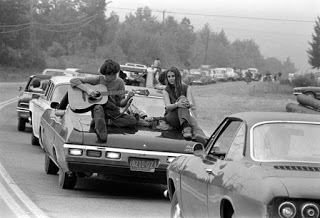 On Wednesday, August 13 (two days before the Festival began), 50,000 early arrivals walked through gaps in the fence where gates had yet to be erected. Organizers were forced to make the event a free concert. This declaration had two dire effects: Woodstock Ventures would lose massive amounts of money, and when news spread of a free concert, an estimated one million people made their way to tiny Bethel, New York. Police turned away thousands of cars. The highways in the area became literal parking lots as people abandoned their cars and walked the final distance to the Festival. Traffic was so bad that organizers had to hire helicopters to shuttle the performers from their hotels to the stage. An estimated 500,000 people actually made it to Woodstock.
On Wednesday, August 13 (two days before the Festival began), 50,000 early arrivals walked through gaps in the fence where gates had yet to be erected. Organizers were forced to make the event a free concert. This declaration had two dire effects: Woodstock Ventures would lose massive amounts of money, and when news spread of a free concert, an estimated one million people made their way to tiny Bethel, New York. Police turned away thousands of cars. The highways in the area became literal parking lots as people abandoned their cars and walked the final distance to the Festival. Traffic was so bad that organizers had to hire helicopters to shuttle the performers from their hotels to the stage. An estimated 500,000 people actually made it to Woodstock.  Richie Havens & Co.
Richie Havens & Co.Despite the organizers' troubles, the Woodstock Festival started nearly on time. On Friday evening, August 15th, Richie Havens got on stage and officially started the Festival, choppered in while Sweetwater, the scheduled opening act, was caught in traffic. Havens would open the Festival with a rousing impromptu and now iconic jam, "Freedom." As a black performer, Havens was a rarity in the folk-dominated Greenwich Village scene. His sandpaper soft voice and percussive guitar playing caught the ear of folk impresario Albert Grossman, who first signed Bob Dylan and helped create Peter, Paul and Mary. Havens had a long career as a musician, but if he had done nothing else, his performance at Woodstock would secure his place in American music history.
Published on March 28, 2019 06:09
March 26, 2019
From the Novel Miles From Nowhere - Hendrix
 In the dawn's light we witnessed those who remained, the chemically disoriented throngs covered in dried mud. The knoll above the stage was scattered with people and garbage and muck. We retreated to the Hatfield's and found our way inside. People were sleeping, Hatfield was making scrambled eggs, there was coffee and we ate. I needed food. I'd left my medication in the van. I felt weak and my face felt rubbery, but no one said a thing.
In the dawn's light we witnessed those who remained, the chemically disoriented throngs covered in dried mud. The knoll above the stage was scattered with people and garbage and muck. We retreated to the Hatfield's and found our way inside. People were sleeping, Hatfield was making scrambled eggs, there was coffee and we ate. I needed food. I'd left my medication in the van. I felt weak and my face felt rubbery, but no one said a thing. I heard someone say, "Bethel's in the Bible, man. It's the place where Jacob envisioned a stairway to Heaven; the messengers of God going up it and down it." We curled up on an Indian blanket and fell asleep. "Up and down they tramped in the glory of God."
The music, like a dream soundtrack, was familiar, heavy and discordant. I opened my eyes. Farm Girl was drooling on my sleeve. "Come-on. Come-on." It was Hendrix. Jimi was playing "Foxy Lady." The time had come. My father told me all about the journey. He was a journeyman. But it was nice when you got there; when you arrived. Farm Girl and I slipped through the barrier that was now but an accordion of mangled wire mesh. The pyramid of storage boxes was in ruin, much of it poached or toppled, but the fences of Woodstock's DMZ were down and we ambled through the crowd unencumbered. There were throngs of people leaving. I was still perplexed. "Where are they going," I said. I found it disconcerting. "Why are they going?"
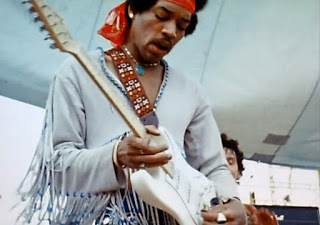 "It’s not about them," Farm Girl said, and then Jimi chimed in, "You can leave if you want to. We’re just jammin', that's all." Those who remained were huddled together, loosely, the band of brothers and sisters like the holocaust aftermath in a science fiction film. Hendrix played "Izabella" and "Gypsy Woman" and "Fire," and then the best; Jimi and the band in radical improvisation, offbeat and discordant, a cacophony both jarring and harmonious.
"It’s not about them," Farm Girl said, and then Jimi chimed in, "You can leave if you want to. We’re just jammin', that's all." Those who remained were huddled together, loosely, the band of brothers and sisters like the holocaust aftermath in a science fiction film. Hendrix played "Izabella" and "Gypsy Woman" and "Fire," and then the best; Jimi and the band in radical improvisation, offbeat and discordant, a cacophony both jarring and harmonious.I blocked it all out, the mud people, the stage, even Farm Girl or my father or Lori or my illness; it was all just Jimi, shining there before me in white leather fringe, his Stratocaster upside down and backward. He was the alpha and the omega. He launched into the "Star Spangled Banner," his guitar so pure and piercing, its dissonance all the news one needed to comprehend the times, the war, the assassinations. He initiated the fire of guns, the bombs bursting in air, all within the confines of a white Fender guitar. It said far more about the timber of America than a hundred partisan tirades.
 But I didn't care about protest and bombs. It was just the sonic possibilities of music. Jimi didn't pluck strings, he whacked them and thwacked them and let the amp's reverberation recirculate through the pickups in a loop of feedback, the guitar virtually playing itself.
But I didn't care about protest and bombs. It was just the sonic possibilities of music. Jimi didn't pluck strings, he whacked them and thwacked them and let the amp's reverberation recirculate through the pickups in a loop of feedback, the guitar virtually playing itself.He played "Purple Haze" and "Hey Joe" and I burst into tears. I sat on the muddy knoll and cried; great tears of sorrow and of joy coursing through me simultaneously. I pulled my knees up and rested my head and that was that. Woodstock was over. I sat for a very long time.
The residue of acid and emotion flew from me suddenly, like a demon exorcised. I looked up and I was alone on Yasgur's Farm. Farm Girl was gone, there was no one on stage, the faithful retraced their steps back to their cars and their homes. I was adrift in a sea of garbage and swill.
And then I saw Farm Girl. In that magic bag of hers, she'd found another outfit, bell-bottomed dungarees and a halter top. She looked fresh and clean somehow and I was filthy like a pig in a sty. She took my mud-crusted mitt in hers and pulled me to my feet. She said, "I'm leaving with the Hatfields," or whatever their name was.
"Oh. You are," I said.
"I am. I have to get home. My family's waiting for me. They worry."
"'Kay."
"I enjoyed our time together. Really. You're a real nice guy." What do you say to that, "Thanks"? What was I going to do, cry out, No, wait, don't go? Of course not. Our parting was inevitable. It just would have been nice to have a little lunch or something, share a meal.
"It was nice." She smiled. "Prettiest smile."
"Hardly." She laughed. "Big ol' space in my teeth. Should of had braces."
"Don't."
"Can't afford it anyway."
"Don't." She hugged me and I kissed her and she walked down the knoll. She didn't turn back. Hatfield was meticulously loading a big bolt of green canvas onto the bed of a truck. He put up the tailgate and the truck pulled away. The little boy saw me up the hill and he waved. So did Hatfield. They got in an orange and white Econoline panel truck. I would have thought a wagon with two black mules. Mrs. Hatfield and Farm Girl got in the other side and they fell in line, the caravan slowly pulling onto the highway. I wasn't feeling sorry for myself, I'd been over that for a long time, but the song in my head was "Fool On the Hill."
It dawned on me that I didn't have any shoes. I watched as the Econoline sat at the intersection, its blinker on. And then it was gone. I walked down the hill and through the trenches. I crossed over the planks and the downed fence to where the tent had been. There was a cardboard box. In it were my shoes and a sandwich and a guitar pick. Maybe it was Jimi's. Maybe it was Hatfield's. Didn't matter. It was nice to have shoes and a sandwich and a souvenir.

- From the upcoming novel Miles from Nowhere
Published on March 26, 2019 23:14
March 24, 2019
A Woodstock Interlude
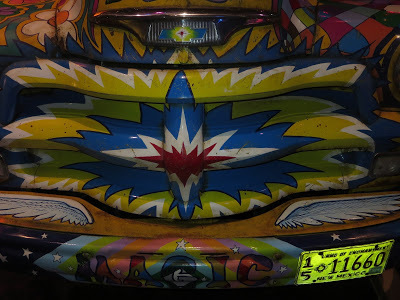 Yesterday, I once again had the opportunity to get to Woodstock, and more specifically to Bethel Woods where the festival actually took place (some 50 miles away). I wasn't there in '69, I would have been 8 years old (wouldn't that have been a hoot?), still there was a great sense of emotion that I shared with those at the museum and in town, and those who had been there or more readily experienced the era. Not to mention the ability to share that emotion, or the awe of it, with my son. As a Californian, I would have been much more likely to gravitate to Monterey Pop, but honestly, despite its immensity and my California bias, Monterey was a concert; Woodstock was a life-altering event, even for those us who weren't there. When you read Miles From Nowhere, you'll get that sense of wonder as well.
Yesterday, I once again had the opportunity to get to Woodstock, and more specifically to Bethel Woods where the festival actually took place (some 50 miles away). I wasn't there in '69, I would have been 8 years old (wouldn't that have been a hoot?), still there was a great sense of emotion that I shared with those at the museum and in town, and those who had been there or more readily experienced the era. Not to mention the ability to share that emotion, or the awe of it, with my son. As a Californian, I would have been much more likely to gravitate to Monterey Pop, but honestly, despite its immensity and my California bias, Monterey was a concert; Woodstock was a life-altering event, even for those us who weren't there. When you read Miles From Nowhere, you'll get that sense of wonder as well.A man with a long white beard sat next to my son on a psychedelic school bus made to emulate the Merry Prankster's Further. During a short film inside the bus, the man said, "That was the music they were playing when I came home from Vietnam." "So you didn't get to Woodstock?" my son asked. He said, "My country had something else in mind." It was the kind of buzz that permeated the building. I would maintain that many of the performances - Jefferson Airplane, Hendrix, Janis - were better in Monterey, but if that kind of vibe was evident in a museum on a chilly fall day, 48 years hence, I can't even imagine what it was like to have been there.

One of the museum's key attractions is a 40-foot film screen surrounded by scaffolding reminiscent of the stage at the Aquarian Exposition. The festival's history is told through interviews of concert goers, locals and promoters. Joe Cocker’s cover of the Beatles' "With a Little Help From My Friends," which turned the lightweight Ringo ditty into a bluesy, cataclysmic rocker, is featured prominently. His soul-baring version of the song was arguably the highlight of the generation-defining festival, rivaled only by Jimi Hendrix' electric version of "The Star-Spangled Banner." Interestingly, Cocker was a virtual unknown before his performance at Woodstock, at least in the U.S., despite a successful debut LP. No one knew of his quirky stage presence, and few were prepared for the emotional aura that Cocker would create that day.
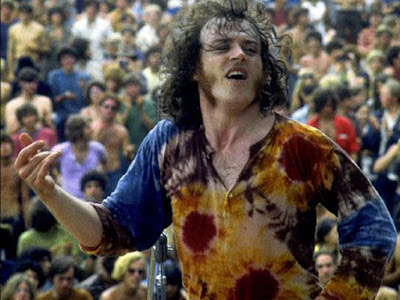
Joe Cocker's voice has always been highly praised or even more severely chided, but one cannot overlook the musicianship of the Grease Band. Alan Spenner (bass), Chris Stainton (keyboards), Henry McCullough (lead guitar), Neil Hubbard (rhythm guitar), and Bruce Rowland (drums), all as obscure as Cocker at the time, sound like an R&B Symphony. Spenner and McCullough's fretwork is raw, Stainton fills the gaps with his B-3 and Wurlitzer piano, and Rowland covers the job of a full percussion section. It is possibly the best performances by a band no one knew, in a time when there were plenty of those (Big Brother and the Holding Company come to mind).
Having been on the road and touring, Joe and the Grease band were well rehearsed, with incredible arrangements of Dylan's, "Just Like A Woman" and "I Shall Be Released" that have intense emotional overtones few young singers could match (Dylan included). His take on the classic "Let's Go Get Stoned," is far superior at Woodstock to even the fine version on the live album, Mad Dogs & Englishmen. "I Don't Need No Doctor," the hit, "Feeling Alright", and tunes like "Dear Landlord” made for a set that was far superior to any of the parts, magnificent as many of them were. The set ends, of course, with Cocker’s majestic take on "With A Little Help From My Friends," a performance that essentially stole the show and put Cocker on the map as a major rock 'n' roll draw. When one thinks of Woodstock, Joe Cocker, in his multi-colored tie-dyed t-shirt, is the most enduring symbol of a historic musical event. I can hear him now in my head.
AM is supported through the sales of Miles from Nowhere and from Jay and the Americans. Read both for free on Kindle Unlimited, or get the Kindle edition (Miles - $2.99; Jay - $5.99) or the trade paperbacks (Miles - $10.99; Jay - $12.99) by clicking the link in the sidebar.
And remember to listen to AM on Daybreak USA and iHeartRadio!
Published on March 24, 2019 06:44



